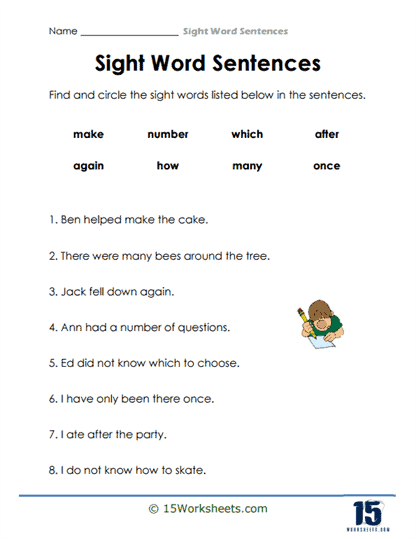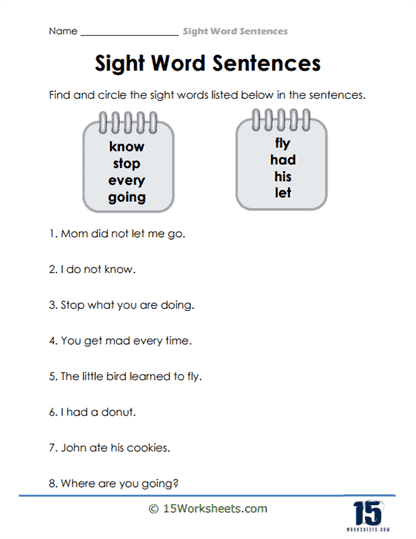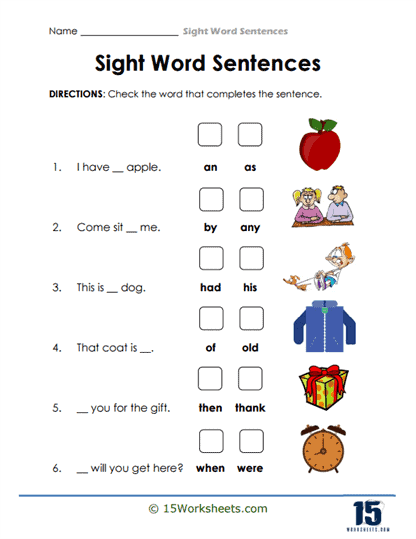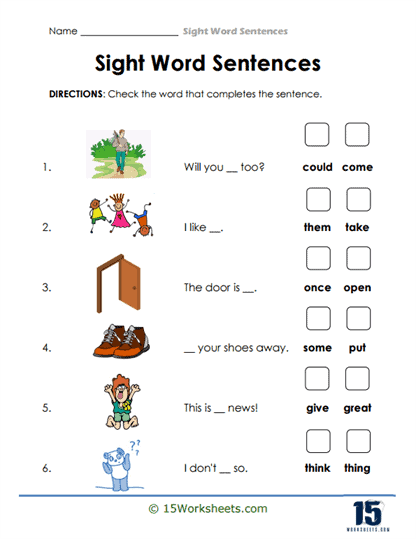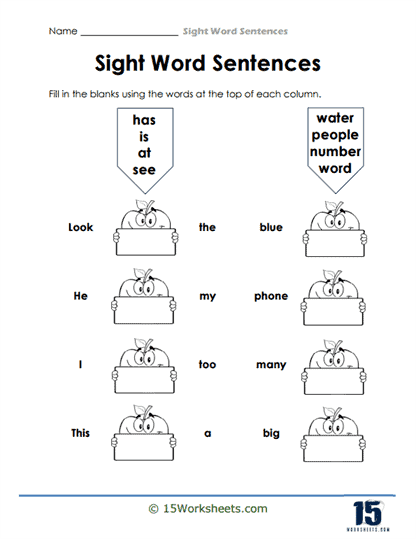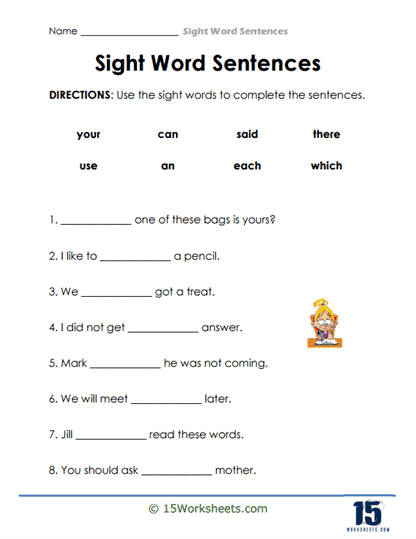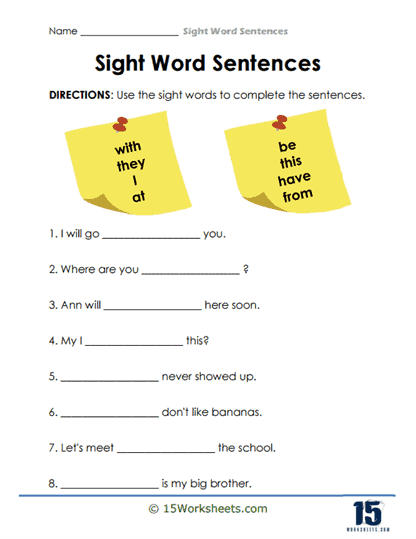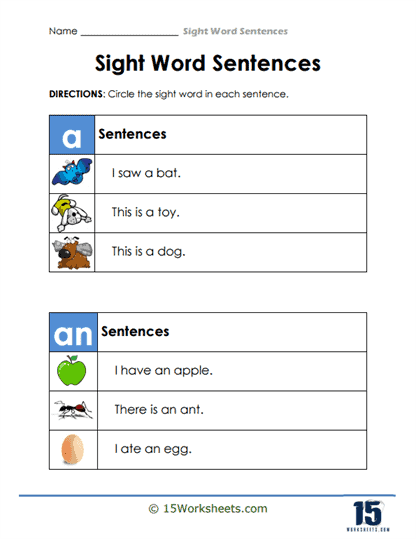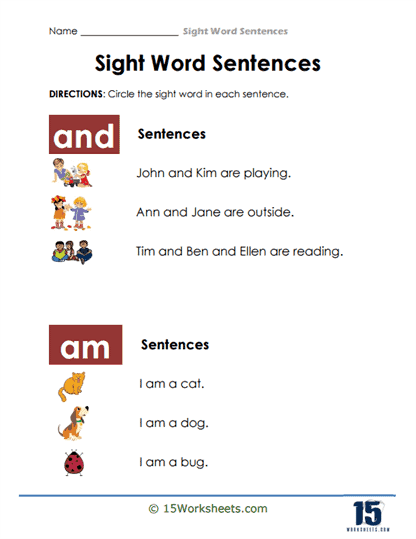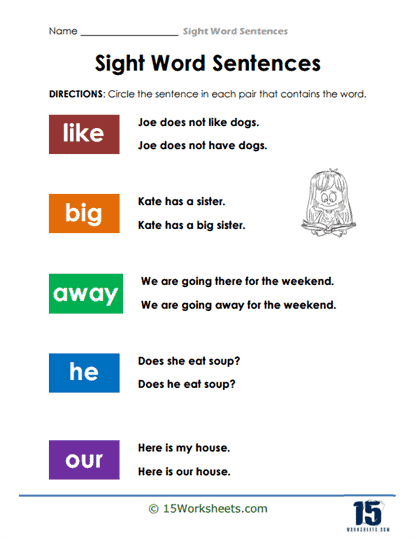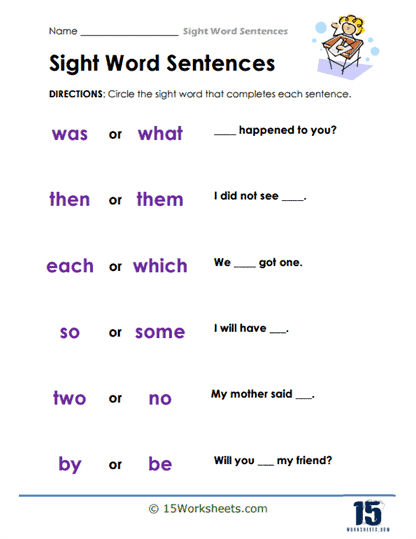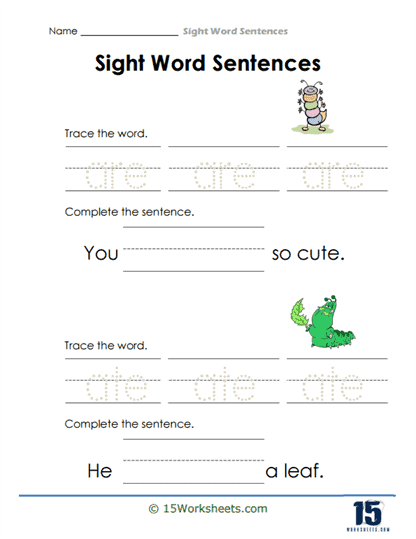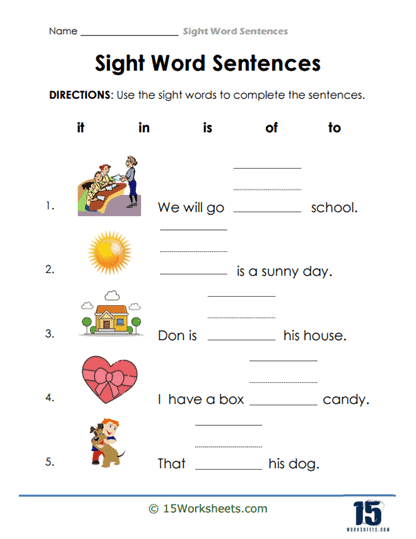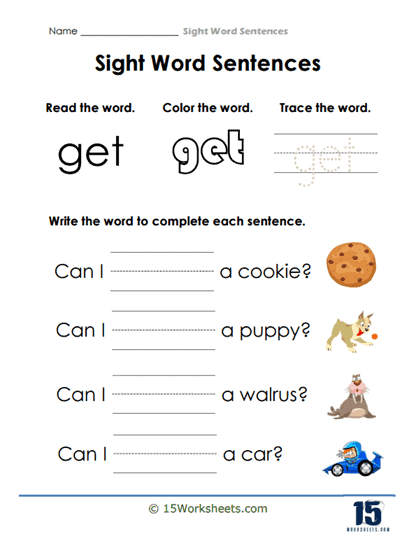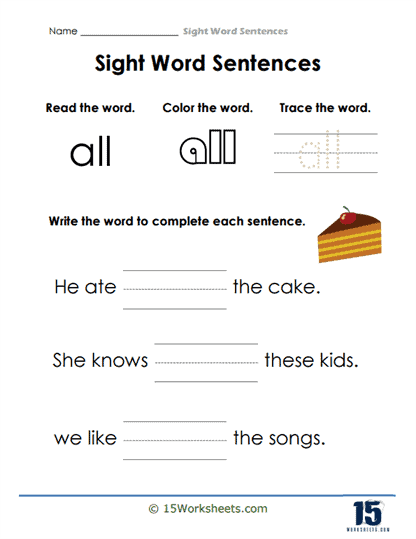Sight Word Sentences Worksheets
About These 15 Worksheets
Sight words are the cornerstone of early literacy, forming a bridge between the decoding process of learning to read and the fluency required to fully engage with text. These high-frequency words, often irregular in their phonetic structure, appear so often in written language that recognizing them instantly becomes crucial for young readers. To support this development, sight word worksheets are an invaluable resource, offering structured yet engaging activities that not only teach recognition but also deepen students’ understanding of how these words function within sentences. The purpose of these worksheets extends beyond mere memorization; they help children transition from struggling to sound out every letter to effortlessly recognizing whole words, fostering a smoother, more fluent reading experience.
At the heart of these worksheets is the goal of improving sight word recognition. In the early stages of reading, children encounter words that defy traditional phonetic rules. Words like “the,” “said,” or “was” cannot easily be decoded by sounding them out, so recognizing them on sight becomes essential. By repeatedly encountering these words in a variety of exercises, students begin to internalize them, which speeds up the reading process. This fluency allows children to focus more on comprehension rather than being bogged down by individual word decoding. In fact, the ability to recognize sight words quickly is often one of the key indicators of reading success in young learners.
One of the most valuable aspects of sight word worksheets is their ability to integrate these words into sentences. This practice does more than help with recognition-it teaches students how words function within a broader context. By seeing sight words embedded in sentences, children learn about sentence structure, word roles, and grammatical relationships. They start to recognize that words are not isolated entities but parts of a larger whole, contributing meaning and cohesion to language. For instance, when a child is asked to fill in a blank in a sentence with the appropriate sight word, they are not just memorizing a word; they are learning how that word fits within a sentence and contributes to its meaning. This dual focus on word recognition and contextual understanding is a critical step in developing both reading comprehension and linguistic awareness.
Sight word worksheets are designed with variety in mind, ensuring that learning remains dynamic and engaging. The different types of exercises included offer multiple ways for students to interact with words, which caters to different learning styles and keeps the activities fresh and interesting. For example, word recognition drills encourage students to focus on visual memorization, while matching words to pictures links words to their meanings in a tangible way. These kinds of exercises help solidify the connection between a word’s appearance and its meaning, making the word more memorable and useful in both reading and writing.
Beyond reading, these worksheets serve a critical function in developing writing skills. Many exercises ask students to complete or construct sentences using sight words, reinforcing correct spelling, and usage. In doing so, children not only learn to spell the words correctly but also practice forming sentences that make sense, which improves both their understanding of grammar and their ability to express themselves clearly in writing. As they progress, students move from recognizing sight words to using them in their own writing, marking a significant leap in language acquisition and literacy skills.
These worksheets provide an opportunity to strengthen cognitive abilities, such as attention and memory. For instance, exercises that require students to find specific sight words in a block of text or to unscramble letters to form a word demand concentration and mental focus. These activities challenge students to distinguish between familiar and unfamiliar words, sharpening their overall reading abilities. The repetitive nature of sight word activities reinforces memorization, making it easier for students to recall these words in future reading endeavors, both in school and in everyday reading tasks.
The diversity of exercises offered in sight word worksheets ensures that each aspect of language learning is touched upon. Word recognition drills, for example, help students focus solely on reading and pronouncing the word correctly, which builds fluency. On the other hand, matching words to pictures brings an element of visual learning into play, as students begin to associate the sight word with concrete objects or actions. This not only aids in word recognition but also helps expand their vocabulary by reinforcing meaning.
Fill-in-the-blank exercises encourage students to think about context and meaning. By presenting sentences with missing sight words, these activities prompt students to draw on both their vocabulary and comprehension skills. In choosing the right word to complete a sentence, they must consider how different words function within a sentence, which strengthens their overall understanding of language structure. This kind of exercise requires them to think critically about what makes sense within the given context, honing both their problem-solving skills and their grasp of grammar.
Some worksheets incorporate word scrambles, where the letters of a sight word are presented out of order and students must rearrange them to form the correct word. This type of exercise is particularly beneficial for developing spelling skills, as it requires students to pay close attention to the letters that make up a word. By interacting with sight words in this way, children become more familiar with the structure of the words and are better able to recall them during reading and writing activities.
In other exercises, such as sentence construction tasks, students are given a list of sight words and asked to form sentences. This activity encourages creative thinking, as students must come up with meaningful and grammatically correct sentences using the provided words. It also reinforces the practical application of sight words, showing students that these commonly used words are integral to everyday language. The act of constructing sentences helps deepen their understanding of how language works and encourages them to use sight words actively, not just recognize them passively.
Reading comprehension exercises are included in series. These typically involve short passages or sentences containing sight words, followed by questions that assess understanding. These exercises help ensure that students are not only recognizing sight words but also grasping their meaning within a larger context. By focusing on comprehension, these activities help young readers develop the skills necessary to understand and interpret written texts, setting the stage for more advanced reading as they progress.
The thoughtful design of sight word worksheets makes them a powerful tool in early literacy education. By combining repetition with contextual understanding, varied activities, and practical application, these worksheets help young readers build a strong foundation for future success in reading and writing. As students engage with sight words in different ways-through reading, writing, and comprehension exercises-they develop the essential literacy skills that will support their continued academic growth.
How These Worksheet Help Students
This series of worksheets are more than just simple tools-they are carefully designed resources that play a vital role in a child’s literacy development. These worksheets touch upon multiple aspects of reading and language learning, offering students a comprehensive approach to building essential literacy skills. By using sight word worksheets regularly, students not only improve their reading abilities but also gain confidence, enhance their vocabulary, and develop critical thinking skills. Let’s dive deeper into how these worksheets contribute to each of these areas, transforming young learners into confident, fluent readers.
Enhanced Word Recognition
The most immediate benefit of sight word worksheets is the improvement in word recognition. Sight words, by their nature, are high-frequency words that students encounter repeatedly in everyday reading materials. Many of these words don’t follow standard phonetic rules, so students must memorize them to read fluently. Regular exposure to these words through targeted worksheets helps students recognize them more quickly and with greater accuracy. Over time, this automatic recognition becomes second nature, allowing students to read more smoothly and with fewer pauses. By practicing sight words consistently, students eliminate the need to stop and decode these common words, which speeds up their reading and fosters better fluency. This fluency is crucial, as it allows children to focus on more complex aspects of reading, such as comprehension, instead of getting stuck on individual words.
Improved Reading Comprehension
When students become proficient at recognizing sight words, their reading comprehension significantly improves. Comprehension is the ultimate goal of reading, and without a strong foundation in sight word recognition, young readers often struggle to understand the material they are reading. By familiarizing themselves with high-frequency words, students can shift their focus from decoding each word to grasping the overall meaning of the text. This shift is transformative. Suddenly, instead of laboriously sounding out words, students can engage with stories, answer questions, and follow narratives with ease. The more fluent they become with sight words, the more mental energy they can devote to understanding and interpreting what they read. In essence, sight word worksheets pave the way for deeper and more meaningful interactions with text.
Vocabulary Expansion
Beyond improving fluency and comprehension, sight word worksheets also contribute to vocabulary expansion. As students are exposed to a broader range of sight words, they naturally build a more diverse vocabulary. This expansion is crucial as it enables students to engage with increasingly complex texts as they advance in their reading journey. By encountering these words in various contexts-through sentences, fill-in-the-blank activities, and matching exercises-students develop a nuanced understanding of their meaning and usage. This growing vocabulary doesn’t just improve their reading skills; it also enhances their ability to express themselves, both in writing and conversation. As their vocabulary expands, students gain the tools they need to tackle more advanced reading materials with confidence and understanding.
Spelling and Writing Skills
Sight word worksheets also play a critical role in honing students’ spelling and writing skills. Activities such as word scrambles and sentence construction require students to focus not only on recognizing words but also on spelling them correctly. By frequently encountering the correct spelling of sight words, students reinforce their memory of how these words are structured. Sentence construction activities, where students are tasked with using sight words to form coherent sentences, go even further by promoting grammatical understanding. These exercises teach children how to create meaningful, grammatically correct sentences using the words they’ve learned, blending spelling practice with writing skills. As a result, students become more confident in their ability to spell and write, enhancing their overall literacy abilities.
Increased Reading Confidence
As students become more proficient at recognizing sight words, their reading confidence naturally grows. One of the biggest barriers to reading success is the fear of making mistakes or struggling with unfamiliar words. By mastering sight words through regular practice, students gain a sense of accomplishment. They no longer feel intimidated by common words that used to trip them up. This newfound confidence leads to a more positive attitude towards reading and encourages students to tackle new and more challenging texts. When students feel confident in their reading abilities, they are more likely to take initiative, read independently, and develop a lifelong love of reading. Confidence is an essential component of literacy development, and sight word worksheets help build it step by step.
Attention to Context
An important skill that sight word worksheets develop is attention to context. Exercises like fill-in-the-blanks and sentence construction not only test students’ knowledge of sight words but also challenge them to consider how these words fit into different sentences and situations. This focus on context helps students understand how words function within the larger framework of language. For example, filling in the correct sight word in a sentence requires them to think critically about meaning and sentence structure. These types of exercises teach students to read for understanding, ensuring they comprehend not only the individual words but also how those words contribute to the overall meaning of a sentence or passage.
Memory and Recall
The repetitive nature of sight word worksheets strengthens students’ memory and recall abilities. By seeing, reading, and writing the same words repeatedly, students commit these high-frequency words to long-term memory. This kind of repetition is vital for young learners, especially when it comes to mastering irregular words that don’t follow typical spelling patterns. Over time, this repeated exposure ensures that students can quickly recall sight words when reading, which speeds up the reading process and enhances fluency. Improved memory and recall also benefit other areas of learning, as students are able to draw upon their vocabulary more easily in both reading and writing contexts.
Critical Thinking and Problem Solving
Sight word worksheets are not just about rote memorization-they also encourage critical thinking and problem-solving. Activities like crossword puzzles and word sorting challenge students to think beyond simple recognition and engage with the words in more meaningful ways. For example, when sorting words into categories based on attributes like the number of letters or vowel sounds, students must analyze the words, identify patterns, and make connections. This type of critical thinking fosters a deeper understanding of the language and builds problem-solving skills that are essential for success in all areas of education.
Phonemic Awareness
While sight words are often taught through recognition, incorporating them into different contexts can also enhance phonemic awareness. Phonemic awareness refers to the ability to hear, identify, and manipulate the individual sounds in words. Even though many sight words don’t follow phonetic rules, engaging with them in activities such as word sorting or sentence construction helps students better understand the relationship between sounds and letters. This phonemic awareness is a critical foundation for reading success, as it helps students decode new words more easily, even when those words don’t follow familiar patterns.

